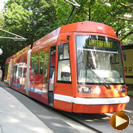< previous
Incentives
The infrastructure of our rail system is rusting away... waiting to be fixed; the project would put scores of thousands of people to work at meaningful jobs at all levels.
The past saga of survival for U.S. railroads was accomplished on two tiers:
- Solidifying Trunkline Mains as a result of mergers over the last fifty years; and
- Hundreds of viable feeder lines salvaged or spun-off from the merged mega railways.
We must recognize that future survival depends on down-scaling and re-localization. To revive our train system it will be important to rehabilitate branchline rail connections to many places now truck-dependent. Smaller cities and industries near dormant railroad corridors that are not of interest to operating shortline operators will need to approach operators, and form local consortiums or partnerships to reconnect.
 Bailing out Detroit should be more than just ramping back up the car assembly lines. In 1941, GM made the transformation from cars to armaments in a matter of months; why can't it produce the rolling stock for a renewed passenger rail system? Or jump start remaking trolleys once more? Bailing out Detroit should be more than just ramping back up the car assembly lines. In 1941, GM made the transformation from cars to armaments in a matter of months; why can't it produce the rolling stock for a renewed passenger rail system? Or jump start remaking trolleys once more?
Why hasn't anybody in a position of authority thought about restoring America's mothballed passenger rail terminals to their old position as the local and regional hubs of a revitalized national passenger rail network?
"It is fantastically expensive to get high speed rail started and time consuming to build, not least because it involves the taking of much private property for the new right-of-way.
Arguably, many more communities could be served, sooner and for far less money, by projects that simply boosted the speed of passenger trains upward to around 110 mph, which would allow them to run on existing tracks and share the cost of the infrastructure with slower but profitable freight trains. This approach has the added benefit that capital spending for improved track and signaling would help freight railroads to get more trucks off the highways, even as it provided many more Americans with passenger service that is fast enough to beat driving or taking a plane. It’s a humble vision compared to that of gleaming bullet trains, but perhaps a more practical and equitable one as well."
- Phillip Longman
Leadership on the Federal level is still sorely lacking on this. If our government declared this to be a national policy objective and made bailouts and tax breaks conditional on retooling for energy-efficient vehicles (not just automobiles!) the American public and other related industries should follow.
Summary
Sadly, due to the merger mania—triggered by deregulation in 1980—much of the U.S. rail network was abandoned. Much of this contraction was ruthlessly efficient for the bottom line but in retrospect, regretfully short-sighted. Energy-efficient transportation desperately cries out for a re-assessment of our railroads and a return to much of the network they once had. Since the 1960s, nearly half of the nations' rail infrastructure has been abandoned or removed.
The country needs connectivity: seamless frequent and dependable connections between and intercity train, bus, light rail vehicle or airplane. Intermodal travel is efficient and hassle free.
Most of the U.S. public would benefit tremendously from normal rail service on a par with the standards of 1927, when speeds of 100 miles-per-hour were common and the trains ran frequently and on time. The mainline tracks are still there, waiting to be fixed.
What rail really needs is a guaranteed source of funding, much like the Highway Trust Fund for roads. The Highway Trust Fund was created in 1956 to fund the interstate highway system by earmarking fuel and highway-user taxes for roads. During the creation and building of the interstate system, all money went to the highways. Rebuilding the railroads requires intervention and financing of the same scope and magnitude.
Across the globe, really fast trains are electric because they aren't weighed down by onboard diesel generators fueled by heavy fuel tanks. Lighter trains accelerate and decelerate quicker and climb grades more easily. Electrifying more track in the U.S. will be expensive but will be necessary to allow bullet trains.
Efficiency will be the driver in the years ahead. America needs a greener more efficient solution to transportation and trains provide it. Hard choices will have to be made. Doubling the interstate system and widen the major thoroughfares across America will only increase congestion. Building corridors for high-speed rail will cost multi-millions as well but the side-effects of lowering congestion and reducing sprawl will—in the long run—more than offset its cost. But focusing money first on the current rail infrastructure and engaging local communities and State involvement is the key to building consensus and spending money wisely.
For far too long America "de-trained". Now is the time to "re-train" and get back on track to meet the energy and transportation challenges of tomorrow.
< previous |